January 2023, Volume 18, Issue 1

TABLE OF CONTENTS
President's Corner

Happy New Year! I am not a fan of resolutions, but I enjoy reflecting on previous years and how I can learn from them to make better decisions for the future. SESWA is one of the resources I use to help navigate the future with changing federal priorities (regulatory, financial, policy, etc.), shifts in the natural and built environment (climate change, sea level rise, extreme events, etc.), and fluctuations in the needs of communities (resilience, equity, efficient service delivery, etc.). The upcoming Seminar will be a great resource as we plan for the future with a focus on Resilient Stormwater Management Solutions. I am looking forward to seeing you there – we can navigate 2023 together!!
As I mentioned in the last SESWA Newsletter Article, the President creates an Action Plan each year. The Action Plan documents a series of actions to be carried out by the membership consistent with the 2021 – 2026 Strategic Plan. In the last article, I covered two of the eight Action Plan Initiatives for 2023 – continuing service projects and promoting actions a community can take to become more resilient. I would like to highlight two additional Initiatives for 2023:
- Evaluate resources provided to attendees after SESWA’s educational events, specifically our newest offering, session recordings. Similar to how we should all learn and make course corrections based on past experiences, we will compare the usage of conference and seminar recordings and weigh that usage against the cost to produce them. The Conference & Education Committee is taking the lead on this Action Plan Initiative.
- Leverage LinkedIn to increase awareness of SESWA. LinkedIn is recognized as the #1 social media platform in the professional world. We want to responsibly utilize LinkedIn to make stormwater professionals know that SESWA is a resource to help address the challenges we face in 2023. The Communications Committee is taking the lead on this Action Plan Initiative.
As I embark on 2023 (and as football season comes to a close), I am reminded of one of Coach Vince Lombardi’s quotes: Individual commitment to a group effort – that is what makes a team work, a company work, a society work, a civilization work. Please be thinking about ways to become informed, committed, and engaged in SESWA’s work. I highly doubt you will regret it!!
Dave Canaan
SESWA President
Raftelis
Back to the top
Did you miss SESWA’s January Webinar?
It’s not too late to view SESWA’s latest webinar titled Spread the Love - Early Action Can Prevent Unmanageable Workloads Later! Gwinnett County, Georgia Field Operations has adapted to large workloads by spreading the work between in-house crews and contractors while rearranging the timing of certain tasks. Crews focus on emergencies and complaints while contractors are assigned targeted work. A database and GIS are used to prioritize and assign projects while progress is tracked and reports are produced for the MS4 permit. This free one-hour webinar reviewed the County’s approach, shared the database and GIS used to help other local governments manage the unmanageable! SESWA members can view the webinar recording online at no cost, thanks to the generous support of SESWA’s Communications Sponsors and continue the conversation on SESWA’s Community Forum!
| Thank you to our Communications Sponsors! |
|---|
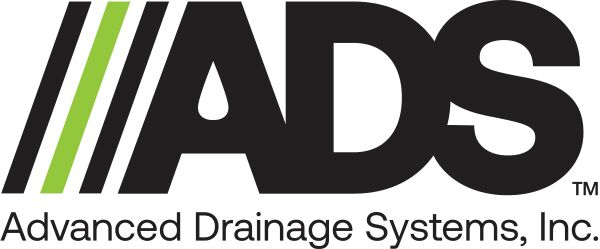 |
 |
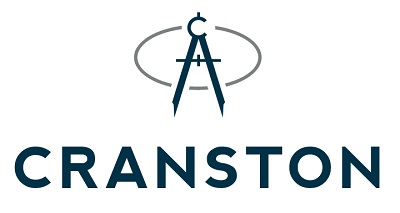 |
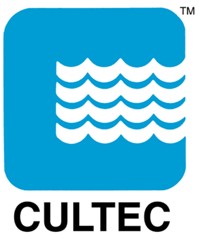 |
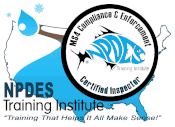 |
 |
Back to the top
SESWA’s Spring Seminar - Registration is Now Open!
Join us for SESWA’s 18th Annual Regional Stormwater Seminar. The Seminar will focus on Stormwater Management for Resilient Communities and will be held April 21, 2023 in Atlanta, GA. Presentations will address a variety of resiliency planning topics from defining, planning and measuring resiliency, to funding and the allocation of resources. Registration is now open!
Back to the top
SESWA’s Spring Seminar Service Project
SESWA is excited to announce that we are planning a service project in conjunction with this year’s Spring Seminar. Plan to join us in Atlanta, GA the morning of April 20, 2023 for this unique opportunity to give back to the environment and the community and spend time together with your peers. More information and registration will be available soon.
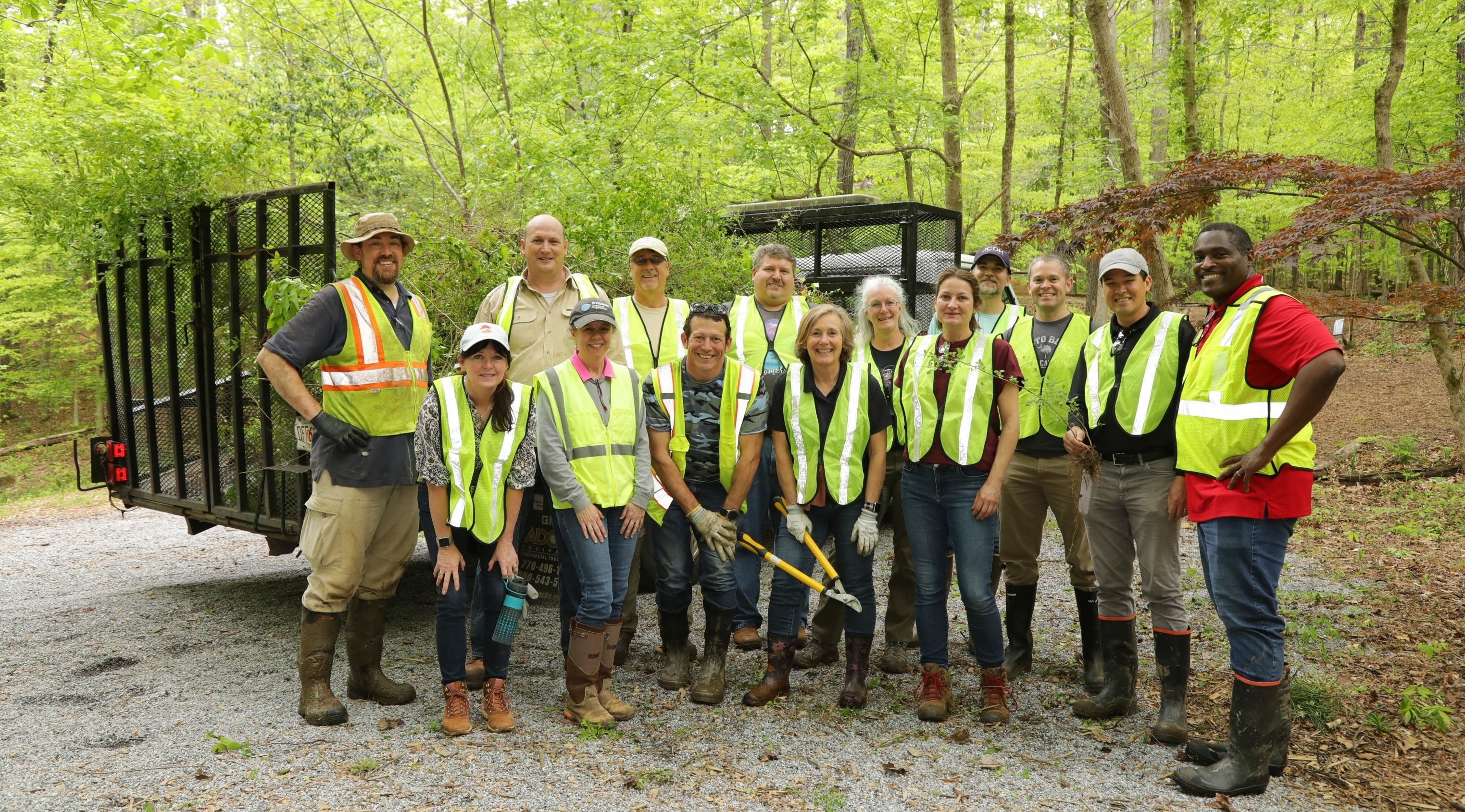 2022 SESWA Seminar Service Project 2022 SESWA Seminar Service Project |
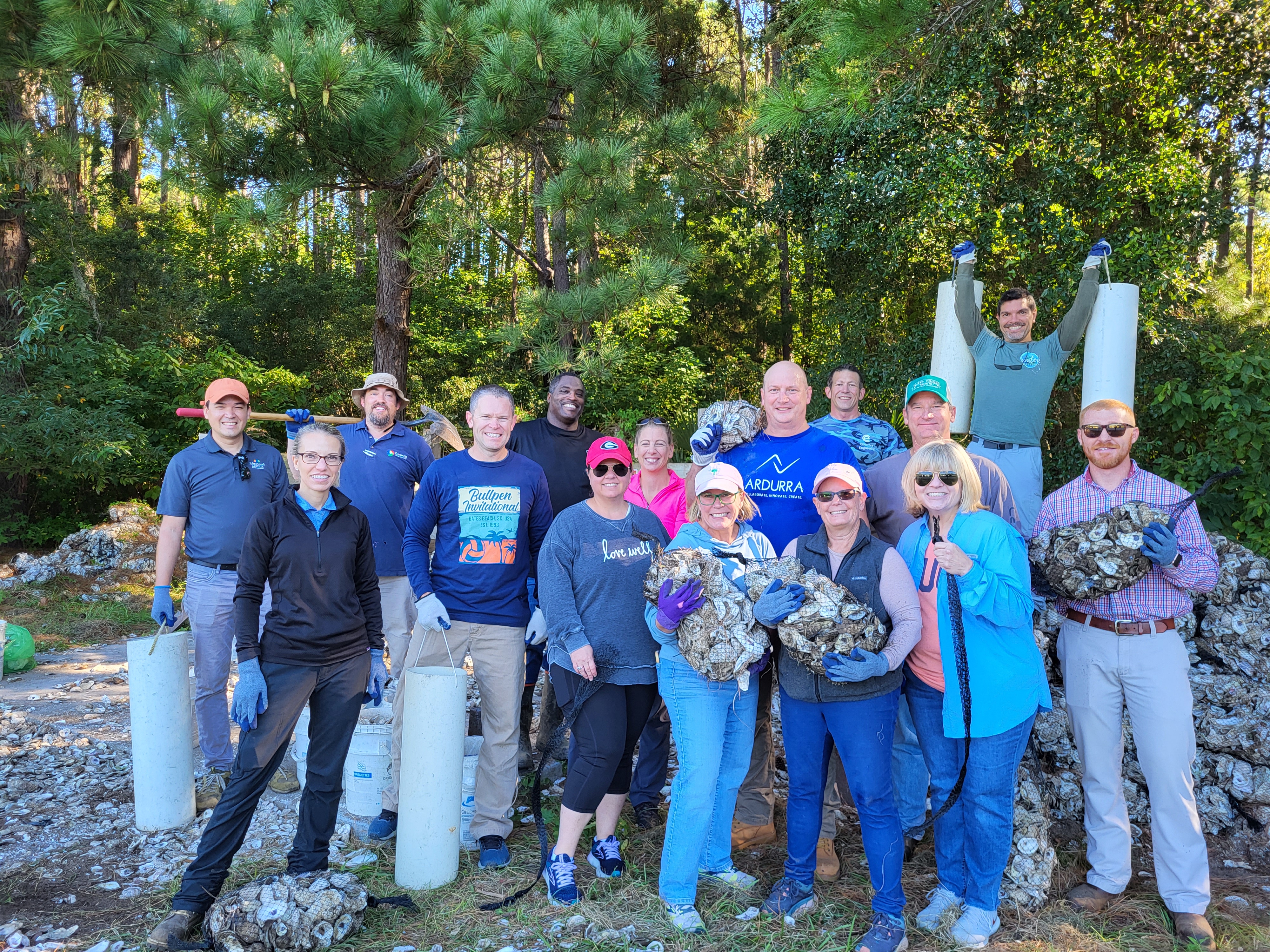 2022 SESWA Annual Conference Service Project 2022 SESWA Annual Conference Service Project |
Back to the top
2023 SESWA Regional Stormwater Conference in Hilton Head, SC
Mark your calendars now for SESWA’s 18th Annual Regional Stormwater Conference. The Conference will be held October 4-6, 2023 in Hilton Head, SC. Circle the date on your calendar now and be on the look out for information coming to your inbox soon – we hope to see you there!
2022 Recordings
SESWA strives to provide the “best of the best” in education and training for stormwater professionals across the Southeast. As part of this initiative, the presentations and recordings from the 2022 Regional Stormwater Conference are now available to all registered attendees. We hope that you find these to be a valuable resource and that access to these resources enhances the value of your conference registration. Registered attendees can access the recordings on the materials page link provided during the conference and was also included in a follow up email after the conference.
Back to the top
2023 SESWA Stormwater Utility Report
SESWA is currently collecting data for its 2023 Stormwater Utility Report. Previous participants should have received an email asking that they review and update information provided in the 2021 survey. Jurisdictions that have not previously participated should have received an email asking whether or not they have a stormwater utility. We ask that you please take the time to respond to these inquiries – your participation not only qualifies you to receive a free 2023 Report, it also helps ensure that this Report remains a valuable resource throughout the Southeast.
Back to the top
Bipartisan Infrastructure Law Funding for Stormwater
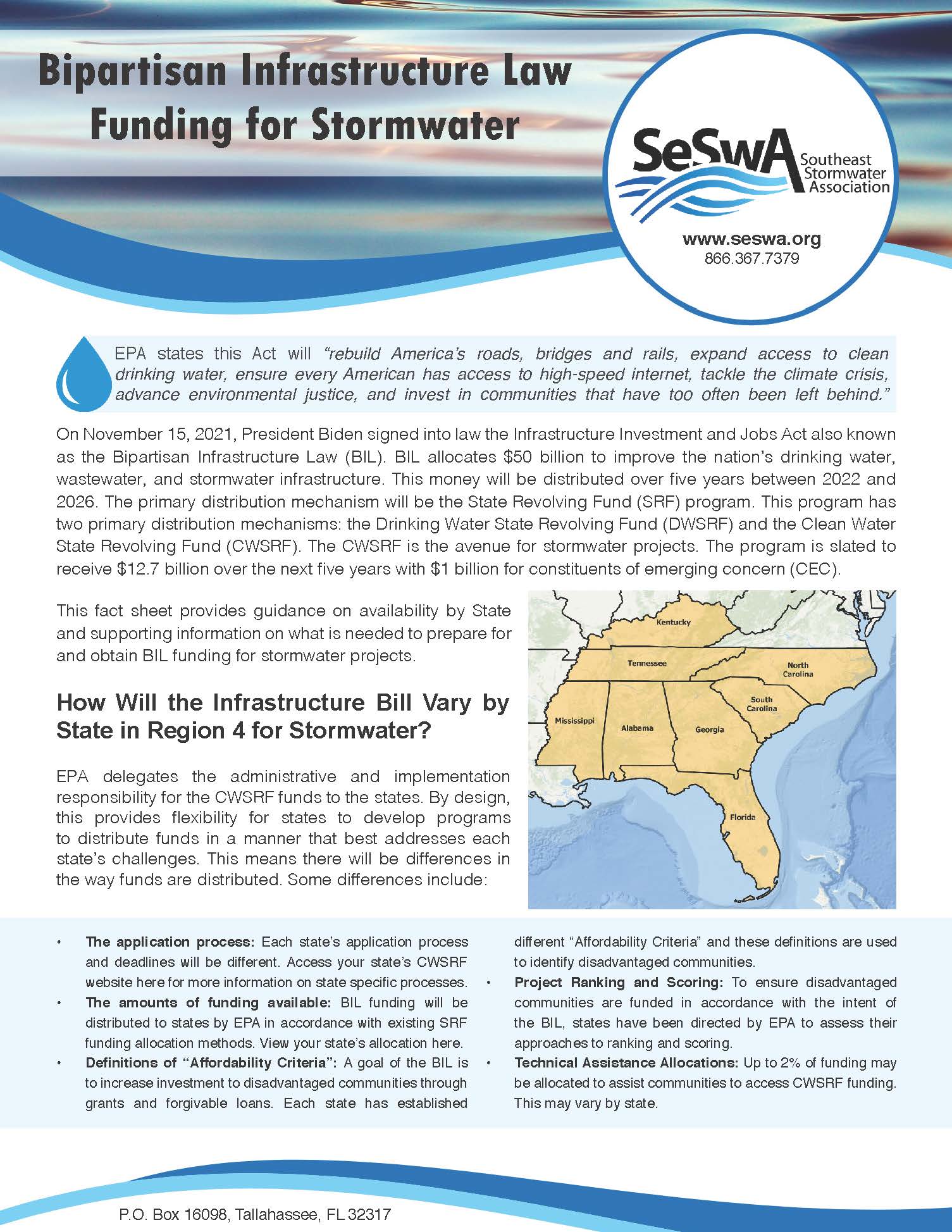 SESWA is pleased to offer a new member resource! View SESWA’s Bipartisan Infrastructure Law (BIL) fact sheet for an overview of BIL with helpful links and state-specific guidance on how your stormwater projects can qualify. Many of these funds will be used to supercharge existing avenues such as the State Revolving Fund program; however, BIL also creates new initiatives to increase the resiliency of our stormwater infrastructure and roadways in some of our underserved communities. BIL funds will be released over the next five years, so there's still time! A big thank you to SESWA’s Stormwater Policy Committee for leading the effort to develop this valuable resource! SESWA is pleased to offer a new member resource! View SESWA’s Bipartisan Infrastructure Law (BIL) fact sheet for an overview of BIL with helpful links and state-specific guidance on how your stormwater projects can qualify. Many of these funds will be used to supercharge existing avenues such as the State Revolving Fund program; however, BIL also creates new initiatives to increase the resiliency of our stormwater infrastructure and roadways in some of our underserved communities. BIL funds will be released over the next five years, so there's still time! A big thank you to SESWA’s Stormwater Policy Committee for leading the effort to develop this valuable resource!
Back to the top
Final WOTUS Rule Published
The final WOTUS rule was published on January 18, 2023 in the Federal Register. This starts the 60-day clock to challenge the rule in federal court which would make the rule effective March 20, 2023. The new rule is generally based on the pre-2015 definitions and appears to be a middle ground between the 2015 “Clean Water Rule (CWR)” and the 2020 “Navigable Waters Protection Rule (NWPR).” The 2015 CWR sought to clarify what was a jurisdictional water, although it did so by significantly expanding the WOTUS definition. That rule was repealed in 2019 and then replaced in 2020 by the NWPR, which significantly narrowed the definition. Federal courts stayed implementation of the 2020 rule and once that occurred, EPA went back to enforcing the CWA based on the pre-2015 definitions.
The impacts of the final rule remain to be seen. Challenges will certainly be filed and don’t forget that the Supreme Court of the United States is expected to issue a ruling soon in Sackett v. EPA. This case asks the Court to clarify when the Clean Water Act applies or does not apply to wetlands. Stay tuned for how the Court’s ruling may impact the new WOTUS rule.
While the new rule seems to have a narrower application than that of the 2015 regulations, it does contain language for “significant nexus” and “relatively permanent” tests, which will be subject to interpretation by regulators. Waterbodies that meet either test will be jurisdictional and subject to EPA and Corps permitting requirements.
Nonetheless, the final rule has several clarifications and improvements for local governments required to obtain Municipal Separate Storm Sewer System (MS4) permits. Specifically excluded from the definition of WOTUS (in large part continued from the 2020 NWPR) are certain:
- Waste treatment systems, including ponds designed to meet CWA requirements
- Ditches excavated in and draining dry land
- Artificial lakes or ponds
- Waterfilled depressions
- Swales and erosion control features with low volume and infrequent or short duration flow
For additional information and to stay up to date on the impacts of WOTUS to your stormwater program visit SESWA’s Advocacy page. WOTUS definitions are important to local governments because they form the foundation on which the NPDES, dredge and fill, and numerous other permitting programs are based so SESWA will continue to monitor rule development and will keep you informed.
Back to the top
Addressing PFAS Discharges in NPDES Permits
EPA recently issued guidance that urges states to include site-specific technology-based effluent limits to address PFAS in Clean Water Act (CWA) discharge permits, while also stating the permits should contain water quality-based limits, if necessary, to attain state standards.
In a December 5, 2022 memo from EPA to EPA Regional Water Division Directors, EPA pledges to work with state-authorized permitting authorities to “leverage NPDES permits to reduce PFAS discharges to waterways at the source.” The memo provides steps that permit writers can implement under existing authorities. Included in the guidance are BMPs to address PFAS-containing firefighting foams for stormwater permits. The potential PFAS-related initiative aims to align wastewater and stormwater NPDES permits and pretreatment program implementation activities with the goals outlined in EPA’s PFAS Strategic Roadmap.
Back to the top
Identifying Sources of Bacteria - MST Analysis in Greenville County
James Riddle, Woolpert
Like many MS4 permittees across the Southeast, Greenville County, SC is subject to requirements associated with long-standing bacteria TMDLs. The County is responsible for its stormwater discharges across its entire unincorporated area, not just the urbanized areas. Many of the watersheds included in the TMDLs are predominantly undeveloped or include farming/agriculture, each of which include obvious sources of bacteria that are not regulated by the County.
To better characterize possible pollutant sources within the TMDL watersheds, the County began conducting microbial source tracking (MST). The primary intent of the characterization has been to properly identify the bacterial sources to select appropriate BMPs or to notify others regarding their respective contributions. Due to the cost of MST analysis (approximately $200-$400/species) from commercial labs, analyses were completed for specific species by watershed, based upon land use and probable sources.
The focus upon specific host species for bacteria and the abundance of possible hosts requires caution when interpreting results. However, results to date have indicated that the most prevalent sources of bacteria have originated from ruminants, most likely from wildlife and farming/agriculture. Additional testing continues, but these initial results indicate that the MS4 is not the primary contributor of bacteria in these watersheds.
Back to the top
ASCE Infrastructure Report Card Rates Alabama Stormwater as D+
Scott Hofer, Jefferson County DOH, AL
Alabama's overall “GPA” for infrastructure is a C- according to the 2022 ASCE Report. The overall grade was also a C- in the 2015 ASCE Report. Stormwater was graded individually for the first time in 2022 and received a grade of D+. A key recommendation for raising the stormwater grade is capturing stormwater infrastructure inventory data to forecast maintenance and repairs as well as future budgetary needs. Uniform and consistent design standards that consider current and future communities were also recommended. Awareness of the stormwater challenges and effective practices were also considered essential for both citizens and stormwater professionals. Increased funding through user fees and utilities was recommended overall to accomplish these needed elements to raise the grade.
Back to the top
Partnership Possibilities
Maria Price, City of Chattanooga, TN
Partnerships are useful to augment staff resources, bring expertise to the table and achieve programmatic goals. The City of Chattanooga partners with non-profits, like WaterWays, to help extend the reach further into the community, leverage grant funding through collaboration, and help provide and train volunteers. The City participates in a cost-share program with the US Army Corps of Engineers to model and remap area streams and determine extents of flood events to help guide planning and future development. The American Concrete Pipe Association provides in-person training on pipe installation to the City work forces and has provided technical guidance on standard drawings and specifications. The City partners with the American Society of Civil Engineers to provide the Chattanooga Development Symposium, a day long training event with presentations primarily by governing bodies and academia to help streamline development in the Chattanooga Area. These partnerships have helped the City stay on the forefront of stormwater management and build a more resilient Chattanooga!
Back to the top
Changes in Design Requirements for Florida Stormwater Facilities
Steve Peene, Geosyntec
In 2020, the Florida Legislature passed the Clean Waterways Act which directs the Florida Department of Environmental Protection (FDEP) to update its stormwater design regulations. During rulemaking, the Technical Advisory Committee (TAC) identified the need to improve treatment of nutrients and other pollutants. The Applicant's Handbook, Volume I (applicable statewide) and Volume II (regionally applicable by water management district), is the primary guide for stormwater facility permitting and design in Florida. Through the rulemaking process, FDEP identified changes to several chapters in Volume I, including Section 8, Criteria for Evaluation, and Section 9, Stormwater Quality Treatment Requirements. The most significant change is that specific nutrient reduction goals will apply for all projects going forward. Presumptive design criteria, which were based on volume retention, have been eliminated and replaced with specific nutrient/pollutant load reduction requirements that must be verified through modeling/calculations. For all new projects, the required nutrient load reduction is the maximum of
- post-project load less than pre-project load, or
- a minimum 80% to 95% reduction, depending upon the classification of the receiving water.
The Volume II documents are also being updated, but those changes are still in development. FDEP intends to finalize rulemaking in 2023. To view the rulemaking process including workshop recordings and rule drafts visit FDEP’s Clean Waterways Act Rulemaking page.
Back to the top
NACWA Corner
Provided by the National Association of Clean Water Agencies
Emily Remmel, Director of Regulatory Affairs
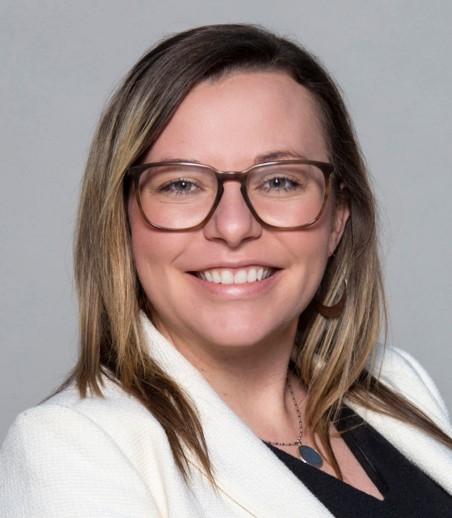
EPA Finalized “Waters of the United States” Definition
The U.S. Environmental Protection Agency (EPA) and the U.S. Army Corps of Engineers' (USACE) finalized the newest iteration of the Waters of the United States (WOTUS) definition on January 18. The final rule, which could be step-one of a two-step process, is currently slated to go into effect March 20, 2023.
Interestingly, and what could force the agencies into a second-step process, is that this Administration’s WOTUS definition was issued ahead of the U.S. Supreme Court’s anticipated decision in Sackett v. EPA. That opinion is expected sometime later this year. It is unclear how this rulemaking will be impacted by the pending case and what the agencies may do if the decision is at odds with the elements of this rule.
EPA and the USACE state that the final rule considers “the relevant provisions of the Clean Water Act and the statute as a whole, the scientific record, relevant Supreme Court case law, and the EPA and USACE’s experience and technical expertise” after nearly a half-century of implementing WOTUS determinations. The final rule largely returns to the pre-2015 regulations (the “1986 regulations”) defining a WOTUS and rejects the 2020 Navigable Waters Protection Rule that it argues “substantially departed” from prior WOTUS rules.
Under the final rule, a WOTUS includes:
- Traditional navigable waters, the territorial seas, and interstate waters;
- Impoundments of WOTUS;
- Tributaries to traditional navigable waters, the territorial seas, interstate waters, or impoundments when the tributaries meet either the relatively permanent standard or the significant nexus standard;
- Wetlands adjacent to traditional navigable waters, the territorial seas, and interstate waters, wetlands adjacent to and with a continuous surface connection to impoundments or adjacent tributaries that meet the relatively permanent standards, and wetlands adjacent to impoundments or jurisdictional tributaries when meeting the significant nexus standard; and
- Intrastate lakes and ponds, streams and wetlands that meet relatively permanent standard or significant nexus standard.
The final rule excludes wastewater treatment systems, including ponds and lagoons, from the definition of a WOTUS. However, the final rule does not explicitly exclude stormwater control features or water recycling structures – both of which NACWA advocated be maintained to provide greater certainty to communities investing in climate resiliency and improved downstream water quality. While most POTWs likely discharge into clearly jurisdictional waters, other tools like green infrastructure and water reuse efforts could be entangled in case-by-case jurisdictional disputes.
Members of Congress have also expressed their displeasure with the final rule and suggested employing Congress’ Congressional Review Act authority to invalidate the regulation.
NACWA continues to monitor the ebb and flow of WOTUS and will keep SESWA members informed of any major developments.
If SESWA members have any questions, please do not hesitate to contact Emily Remmel, NACWA’s Director of Regulatory Affairs at [email protected] or 202-533-1839.
Don't see news from your state?
Please contact us with your news or share your comments on our newsletter by emailing us at [email protected]. |
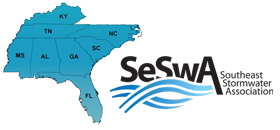









 SESWA is pleased to offer a new member resource! View
SESWA is pleased to offer a new member resource! View 
